This has been one of the most pleasant starts to autumn I can remember. Aside from the occasional wet windy day, it’s been warm and fairly calm with lots of sunshine. The combination has brought my butterfly bush back from its August drought-damaged torpor into full bloom. And every day I benefit from seeing fluttering wings from my kitchen window. Today, though, I set some kind of backyard record for the most types of butterflies on one October afternoon in Ontario.
The Marvel of Migrating Monarchs
Despite a rather worrying spring with no Monarchs seen at all since near the end of August, a steady stream of Monarchs has danced through my garden. Once they find the butterfly bush, the wild purple asters are given only a disdainful glance. Instead they stop and tank up, often for an hour or more at a time, before vanishing over the fence.
From time to time, two Monarchs will rise up off the bush and dodge and pirouette and flirt together in front of the dining room window. (Or perhaps fight: I haven’t tried to figure out their gender when this happens.)
So far today we’ve only had one Monarch visit but that’s still one more than I expected on October 11.
Hey These Ladies Aren’t Painted, They’re American!
Two days ago brought three butterflies of a kind I haven’t seen this year. I thought they were Painted Ladies but when I scrutinized my photos I noticed two rather large eyespots on the undersides of the wings. Surprised, I checked my Kaufman’s Field Guide to Butterflies.
I found that there are two kinds of Ladies. The ones in the yard were (and are!) called American Ladies. They are more common in the USA but they do range up into southern Canada.
What I didn’t know is whether they migrate, hibernate or pupate through the winter. So I went looking for the facts.
The Government of Canada Canadian Biodiversity Information Facility website says this butterfly usually arrives from the south as a migrant in May. It then lays eggs and several generations take flight during the summer and early fall. It also says it’s not clear whether they can over-winter successfully in Canada or not.
I could not find any clear evidence for whether these butterflies travel south from Ontario in the fall or not. If they don’t they must at least move around as I have not seen any of them in our yard until this week.
Red Admirals Bring up the Rear of the Retreat
Anyone who lived in southern Ontario in April 2012 knows that Red Admiral butterflies migrate. That was the spring after “the winter that never was” and when the butterflies came north that year they came in squadrons, platoons and companies of thousands. The number on the flowering trees in our neighbourhood was literally countless.
These showy butterflies also retreat south in the autumn but their departure is much less obvious. According to the Nature Conservancy Canada website, Red Admirals do not head for a specific wintering destination like Monarchs. They also have successfully over-wintered as adults.
No Flowers for This Mourning Cloak, a Simple Wall Will Do
The fourth butterfly that graced our gardens today did not visit any of the flowers. It was a Mourning Cloak. They don’t feed on nectar so the butterfly bush passed unnoticed beneath its wings. Instead, it settled on a south-facing red brick wall to bask in the mid-afternoon sunshine.
I wasn’t able to get a good photo so I’ll share this one from the spring instead.
Mourning Cloaks can and do over-winter in Ontario as adults. Many people, including me, have seen them out flying about while there is still quite a bit of snow cover in the bush. When the weather turns cold again, they just hide and wait it out.
According to a state of New Mexico website, Mourning Cloaks are one of the longest-lived butterflies. Individuals have been known to live 10 months. The site also says that hollows in trees are one of the places the butterflies over-winter in that state. They often feed on tree sap. I imagine they should find a good supply leaking from where branches have broken off in spring storms.
So Long for Now!
Today was a very good day for butterflies especially for October. Soon the only thing flying and dancing outside my kitchen window will be snowflakes. But if all’s well in the world, the spring winds will bring some of these insects (or their offspring) back.
Related Reading
- Sexing Monarchs (Butterflies that is)
- What’s this Small Black and Blue “Monarch” Butterfly Doing Near Toronto, Ontario?
Join In
Did you have the usual number of Monarchs visit your neighbourhood this fall? Please share your experiences with a comment.

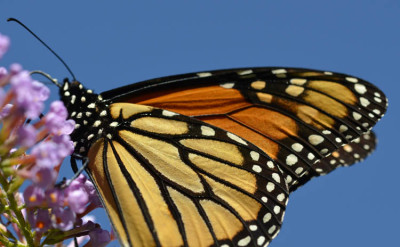
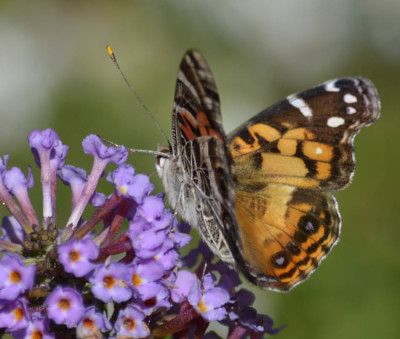
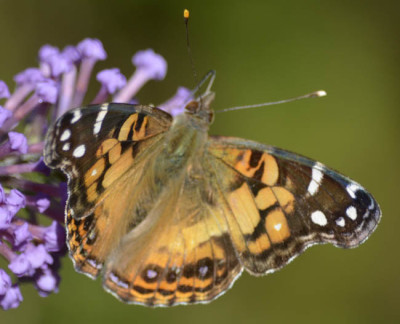
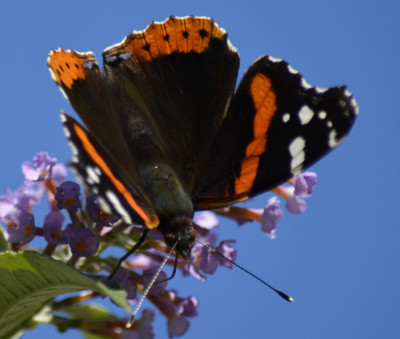
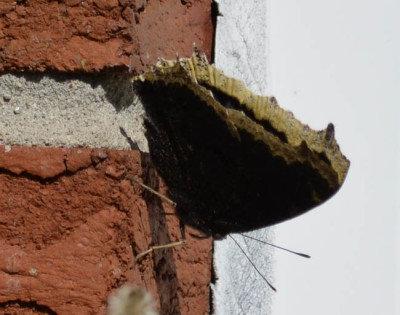
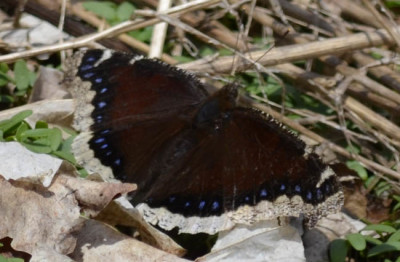
I am in Hamilton, Ontario on Business. Outside my hotel window just now i saw 2 rusty colored butterflies..i am not sure which ones they are.
Any ideas?
Thanks.
btw, the weather is quite warm for this time of year.
I suspect they were Painted Ladies, due the the large numbers migrating right now. Other possibilities include Eastern Commas, Question Marks, Monarchs, Common Buckeyes, and Milbert’s Tortoiseshells. Unfortunately, though, there are also some moths that could look like butterflies at a glance.
If you manage to get a photo of one with a phone etc, you can upload it to e-Butterfly.org as an Unknown Sp. and they will eventually id it if they can.
Either way, it’s neat to see butterflies so late in the year–thanks for sharing!